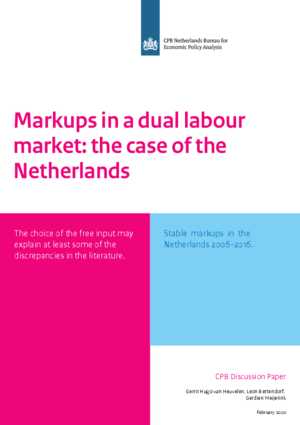Markups in a dual labour market: the case of the Netherlands
Findings are robust to an alternative setup, in which a gross output function is specified and materials are used as free input. Implications for applied work and policy are discussed.
Downloads
Wij volgen de productiefunctie-benadering om de markups te analyseren. Voor een bedrijf dat kosten minimaliseert kan eenvoudig afgeleid worden dat de markup gelijk is aan de verhouding van de outputelasticiteit en het kostenaandeel van een vrije input. Voor een vrije input geldt dat het volume veranderd kan worden zonder enige aanpassingskosten. Het kostenaandeel kan berekend worden met balansdata maar de outputelasticiteit moet worden afgeleid uit de schatting van een productiefunctie. Deze schatten we met een structurele functie uitgedrukt in toegevoegde waarde en we gebruiken tijdelijke contracturen als vrije input. Onze bevindingen zijn robuust voor een alternatieve aanpak, waarin een functie uitgedrukt in bruto-output is gespecificeerd en materialen worden gekozen als vrije input. Ten slotte laten we zien dat het foutief uitbreiden van de vrije variabele met vaste contracturen resulteert in een stijgende markup.
Authors



